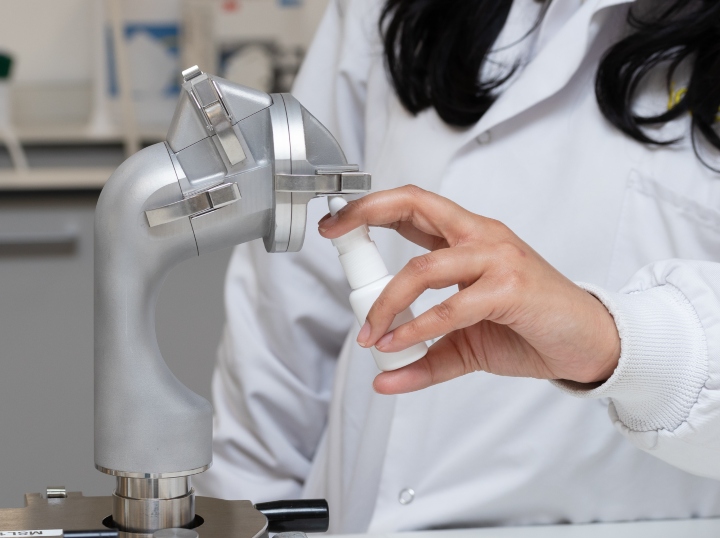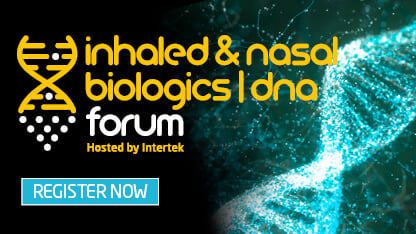Nasal drug product development for nasal spray drug or nasal powder spray pharmaceuticals or vaccines. Optimising intranasal drug performance and quality through formulation, stability, testing and in-vitro bioequivalence study services
Intranasal drug delivery products present significant opportunities to deliver drugs topically or systemically, as well as offering prophylactic (e.g. anti-viral) benefits via innovative formulations or nasal spray devices.
Nasal sprays are non-invasive and generally well tolerated by most patients. As the mucosa offers a number of benefits as a target tissue for drug delivery, intranasal drug administration can be used for both topical or systemic nasal drug delivery. In addition, newer applications include targeting nose-to-brain delivery as well as the lymphatic system for nasal spray vaccines and drug delivery for biologic drugs.. This can provide rapid absorption whilst avoiding the hepatic first-pass effect, where the parenteral administered therapeutic agent is rapidly metabolised by the liver into inactive components, reducing efficacy.
Nasal Drug Delivery Challenges
Challenges for targeted intranasal drugs are presented by complex nasal anatomy which has several specific target areas for delivery. These include the olfactory region, the turbinates, and the Nasal Associated Lymphoid Tissue (NALT) which offer key targets for systemic and neurological delivery as well as targeting specific immune systems responses.
The nasal cavity however also has efficient mucociliary clearance and enzymes in the nasal mucosa which can partially metabolise some drug products (e.g. peptides or proteins) in the nose prior to absorption. Both factors can result in a short window for absorption to occur. Low membrane permeability of large molecular weight drugs (such as protein or peptides) also presents a challenge for formulation.
Analysis, Device Selection and Product Characterisation
Nasal sprays (and also most nasal aerosols) typically produce droplets in the range 20-200 microns, with most sprays typically deliver a proportion (typically <5%) of fine droplets in the <10 micron range, which must be quantified. Our experts conduct particle / droplet size distribution testing and spray pattern / plume geometry using current, industry standard inhaled or nasal drug product analytical testing techniques with validated methods (e.g., cascade impaction, laser diffraction and high-speed laser imaging). Using morphologically-directed Raman spectroscopy (MDRS) we can directly measure the active pharmaceutical ingredient (API) particle size in the nasal suspension with robust identification of both drug and excipient. This technique has become key to generic suspension product development, where equivalent MDRS data, compared with the reference product, may be used in-lieu of clinical, pK end-point data.
We also test the physicochemical properties of the formulation, including; viscosity, aqueous solubility and pH. Our laboratories quantify visible and sub-visible particulates via light obscuration, electron microscopy and other microscope-based techniques. We continually invest in cutting edge nasal drug product equipment, including:
- Proveris SprayView system for spray pattern and plume geometry
- Proveris Vereo automated actuators
- Malvern Spraytec Laser Particle and Droplet sizing
- InnovaSystems automated actuators
- Malvern Morphologi G3-ID with MDRS
- Next Generation Impactor (NGI) and Andersen Cascade Impactor (ACI) for analysis of drug in small droplets/particles (DISP)
- Various spray content uniformity / emitted dose apparatus
- Electronic rotational viscometers (Brookfield)
Nasal Drug Product Stability and Device Compatability
A key requirement of the delivery device is the compatibility with the formulated product with regard to stability. Our team aim to establish if there is any degradation occurring influenced by the materials of construction (including extractables / leachables) and assess if the design is user friendly, reliable in use and gives consistent metering across the life of the product for multi-dose devices. Our experience spans a multitude of devices from the traditional multidose aqueous spray pumps, monodose sprays, dry-powder devices, nasal pMDIs, and nebulisers.
Successful nasal drug development benefits from ensuring well performing drug product with optimised delivery of a precise dose to the specified target area. Intertek offer a full service for either novel or generic products, fulfilling the product characterisation requirements set out in the relevant CMC guidance including patient in-use / mis-use studies, device verification, cleaning studies, dosing to exhaustion and extractables and leachables.
Formulation Development
Nasal formulations can be aqueous solutions or suspensions, dry powders, pressurised solutions or suspensions with a variety of choice for the delivery device. Our formulation team will tailor a development strategy to meet the needs of your product – for example delivery strategies to increase residency time in the nasal cavity using either bio-adhesives or viscosity adjusters to slow down mucociliary clearance and increase the amount of vaccine or drug delivered.
Absorption is a major factor to address during formulation and we can adopt several strategies to optimise this such as using permeability enhancers or surfactants such as polysorbates and lecithin, for example, have been found to increase the solubility and permeability of some APIs.
Nasal Drug Development Expertise
Our team flex their 30 years of inhaled or nasal drug development experience to help you overcome development challenges for nasal solutions, suspensions and dry powders, providing the critical performance and quality testing you need for successful product development. With strategic formulation and comprehensive nasal drug product testing, we drive understanding of where and how the drug will be deposited, as well as ensuring that a safe and robust medicine is developed.
Conducted in Good Manufacturing Compliant (GMP) laboratories, our nasal drug development expertise includes integrated formulation development and scale-up, device screening, accelerated stability studies, clinical supply manufacture and full CMC support to help you optimise the performance of your nasal drug in either aqueous, powder or propellant-driven forms. We routinely provide in-vitro bioequivalence studies (IVBE) for generic products, including full GMP statistical analysis and dossier generation and also significant experience in re-purposing existing drug products for intranasal delivery.
Bringing quality and safety to life, we offer Total Quality Assurance expertise with GMP compliant laboratories equipped with the latest testing instrumentation. We apply our 30 years of experience in analytical and formulation support to the development of nasal solutions, suspensions and dry powders, providing the critical performance and quality testing you need for successful product development.
Intertek Melbourn
GMP Pharmaceutical Analysis and Formulation Expertise
Intertek Melbourn
Saxon Way, Melbourn
Herts, SG8 6DN
UK
Recent News:
Intertek expands pharmaceutical services laboratory to enhance capabilities in inhaled biologics and accelerate drug development
Intertek partners with CrystecPharma to advance formulation science and accelerate development for dry powder inhalers

Pharmaceutical News & Events
- PRESS RELEASE: Lab expansion to enhance capabilities in inhaled biologics drug development
- PRESS RELEASE: Intertek partners with CrystecPharma to advance formulation science and accelerate development for dry powder inhalers
- NEW! Blog: Optimising Quality in Pharma Supply Chains
- Determination of Particles in Pharmaceuticals - Article
- Discover our Audit Live Tool for direct access to our scheduled audits
- Extractables/Leachables Lab Tour - Request access
- Medical Device Extractables & Leachables Studies
- Glycosylation Analytical Approaches for Antibody Therapeutics
- Rapid Determination of Low/Trace Level Benzene in Pharmaceutical Excipients and Finished Products


